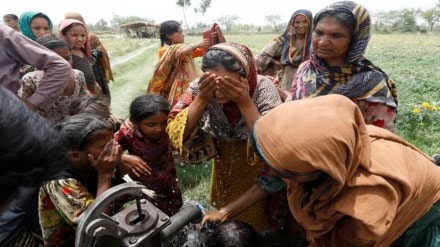By Priyanka Tomar & Neethi Rao
Last summer, record-breaking temperatures, soaring above 50 degrees in some regions, were observed across South Asia including in Bangladesh, Pakistan, and India. The extreme heat triggered widespread health alerts, prompting governments to issue medical advisories and warn citizens about health risks. This was followed by devastating torrential rain in Nepal, Bangladesh, and India in June-September. The region also saw landslides, storms, earthquakes, droughts, and cold waves. This year, heatwave warnings have been issued for many parts, including India. These are not isolated, stand-alone incidents but part of an ever-growing crisis, potentially jeopardising the prospects of our future generations.
According to the Global Climate Risk Index 2020, six of the eight South Asian countries —Pakistan, Bangladesh, Nepal, India, Sri Lanka, and Afghanistan — ranked among the top 25 nations that suffered substantial human and economic losses due to climate change-related extreme weather events between 1999 and 2018. The Emergency Events Database reveals that since 2000 South Asia has experienced over 1,000 natural hazards, with India bearing the brunt.
Children are especially vulnerable to the health impacts of climate change. Unicef’s Children Climate Risk Index 2021 highlights that all South Asian countries are at high risk, with Pakistan and Afghanistan ranking among the top 15 economies most affected by climate vulnerabilities. The combination of high child mortality rates and systemic socio-economic challenges, including poverty and limited access to healthcare, exacerbates the plight of children.
Air pollution is the second highest cause of death among children under five years of age in South Asia, with 164 deaths per 100,000 — significantly higher than the global average of 108 deaths per 100,000 in 2021 (State of Global Air 2024). Infants including newborns, and foetuses are more susceptible to air pollutants as they breathe at a faster rate than adults. As children often spend more time outdoors and are more exposed to air closer to the ground, they are directly exposed to pollutants like dust and vehicle emissions. As of 2023, IQAir found that 42 of the 50 most polluted cities in terms of PM 2.5 levels are located in India, and 46 cities are in South Asia. High pollution level is linked with serious acute respiratory diseases such as asthma, bronchitis, pneumonia, and impaired lung functions, especially among children.
Extreme heat is another emerging cause of morbidity and mortality among children and adolescents in South Asia. Unicef estimates that 76% of children, equivalent to 460 million, under 18 years of age are exposed to extreme high temperatures. Children and adolescents are more vulnerable to heat-related illnesses such as heat strokes and exhaustion, with poor mental development and heightened possibilities of neurological and cognitive dysfunctions. Climate-related school disruptions are also becoming a major concern in South Asia. In 2024 alone, extreme heat affected 128 million students in the region, interfering with their cognitive development and academic continuity, and impacting overall educational outcomes despite the availability of online learning alternatives. Extreme weather events like floods, particularly during monsoon, also force school closures, as seen in Nepal last year. Many public schools in the region suffer from severe overcrowding, inadequate ventilation, and insufficient infrastructure to mitigate extreme heat, with some lacking basic electrification and cooling systems.
Besides, malnutrition remains a persistent concern for most countries in South Asia. According to Unicef data, the region has over one third of the world’s stunted children (roughly 54 million), and more than 25 million suffer from wasting. With climate-induced food insecurity looming large, malnutrition is expected to worsen, increasing the risks of developmental deficiencies among children.
A few practical and necessary solutions can be leveraged to address this emerging concern. To begin with, governments must integrate child welfare into climate policies. This could be done by assessing climate risks specific to children and embedding child-focused strategies within national health adaptation plans. Aiming for a “children in all policies” approach will ensure sustainable development and equitable access to healthcare for all children.
Simultaneously, climate-proofing learning infrastructure should be prioritised, with both public and private investments directed toward resilient schools and ensuring access to effective remote learning options during extreme weather. Nature-based solutions, such as green school buildings, rainwater harvesting, tree planting, agroforestry, composting, and zero-waste systems should be incorporated to create sustainable and climate-resilient learning environments.
Prioritising children’s mental health as a core component of adaptation strategies is also essential, particularly for those facing climate-induced trauma and displacement. This aspect remains largely overlooked in the region.
Strengthening research on climate-health linkages is crucial to systematically study pathways linking stressors with child health vulnerabilities, which will help identify the most appropriate and cost-effective adaptation and mitigation interventions.
South Asia can promote child-centred solutions and collaborate through regional climate resilience programmes focusing on schools and children; educational reforms, including climate-focused curricula and teacher training; developing coordination mechanisms to improve early warning systems; and joint funding mechanisms to support emergency relief efforts for children.
Keeping the theme of this year’s World Health Day in mind (“healthy beginnings, hopeful futures”) it is clear that prioritising children’s health in the face of climate change is not just an option but also an urgent necessity. It’s time for governments, parents, and decision makers across South Asia to act decisively to protect our youngest citizens and their future.
The writers are respectively research associate and fellow, Centre for Social and Economic Progress, New Delhi.
Disclaimer: Views expressed are personal and do not reflect the official position or policy of FinancialExpress.com. Reproducing this content without permission is prohibited.
